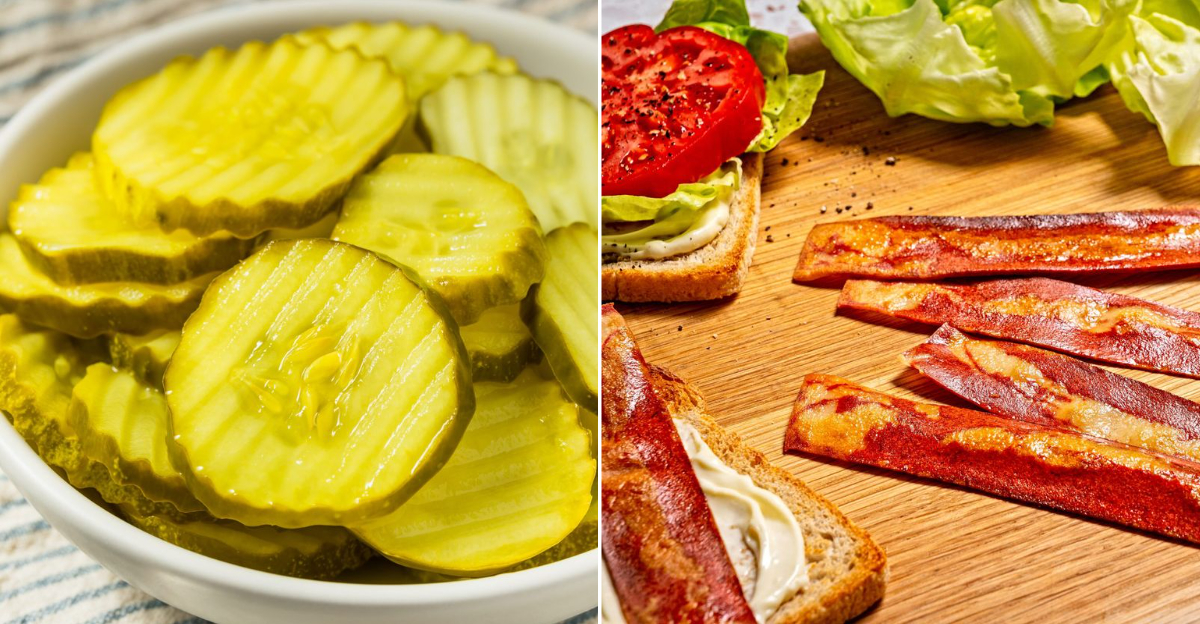14 Burger Toppings That Vanished Overnight Because Of The FDA

Remember when your favorite burger joint suddenly changed their menu? I used to wonder why my go-to loaded burger tasted different one day.
Turns out, the FDA regularly reviews food additives and ingredients for safety, sometimes resulting in swift bans that change our fast food landscape overnight.
These regulatory decisions have quietly transformed the American burger experience, removing toppings we once took for granted.
1. Artificial Bacon Bits
One day they were crunchy, salty little morsels of happiness on my burger, and the next—poof! Gone. The FDA discovered these popular red bits contained Red Dye #3, a coloring linked to thyroid tumors in lab animals.
My college roommate and I used to sprinkle these liberally on everything from salads to burgers, blissfully unaware we were consuming questionable chemicals. The manufacturers had been using the dye to give that signature reddish hue that made them look like real bacon.
When the ban hit, restaurants scrambled to find alternatives. Some switched to natural bacon crumbles, while others simply removed the option. The taste difference was immediate—real bacon has a distinct flavor that chemical approximations just can’t match.
2. Caramelized Onions Cooked In Artificial Margarine
Sweet, golden, and utterly delicious—caramelized onions made with certain margarines were my weakness. Then suddenly, burger joints started advertising “new and improved” onion toppings. The FDA had banned specific artificial trans fats used in many margarine products, sending restaurants back to their kitchens.
The margarine in question contained partially hydrogenated oils that the FDA determined were not “generally recognized as safe.” My favorite local burger spot used to slow-cook their onions for hours in this now-forbidden substance, creating a uniquely buttery-sweet flavor profile.
Chefs nationwide had to revamp recipes overnight, switching to butter or plant oils. The silver lining? The new versions actually taste more naturally sweet, with honest onion flavor shining through rather than artificial butteriness.
3. Pickled Vegetables With Artificial Colors
My mouth waters thinking about those vibrant pickled veggies that added zingy crunch to burgers. The unnaturally bright pink pickled onions and neon-green cucumbers were Instagram-worthy toppings until the FDA stepped in.
Several artificial dyes used to enhance these pickled vegetables—particularly Blue #1 and Green #3—came under scrutiny when research suggested potential links to hyperactivity in children. I remember watching a food documentary where they showed how some pickle producers were using these dyes at levels far exceeding recommendations.
Overnight, the colorful jars behind burger counters were replaced with naturally colored versions. The taste remained largely unchanged, but that electric visual appeal disappeared. Now pickled toppings showcase their natural hues—still beautiful, just subtler and safer.
4. Battered Jalapeños With Added Preservatives
Holy heat bombs! Those crispy, battered jalapeño discs were my go-to burger upgrade until they mysteriously vanished from menus nationwide. The FDA discovered certain preservatives used to extend their shelf life—specifically TBHQ and BHA at high concentrations—showed concerning results in long-term exposure studies.
My brother-in-law worked at a popular burger chain and told me how they received an urgent memo to pull these spicy circles immediately. The preservatives had been helping fast food restaurants keep pre-battered jalapeños shelf-stable for months instead of days.
Most places switched to freshly battered versions or preservative-free alternatives that required refrigeration. The flavor improvement was noticeable—fresher, more vibrant heat that actually tasted like real peppers instead of just generic spiciness with a strange aftertaste.
5. Processed Mushroom Toppings
Mushroom lovers like myself mourned when certain processed mushroom toppings disappeared from burger bars. The culprit? The FDA identified potentially harmful levels of sulfites used to preserve that perfect brown color and extend shelf life.
During college, I worked at a burger joint that received these mushrooms in large plastic tubs. They came pre-sliced, pre-cooked, and suspiciously perfect-looking. When heated on the grill, they maintained their texture remarkably well—too well, as it turns out.
For people with sulfite sensitivities, these mushrooms could trigger serious reactions ranging from headaches to breathing difficulties. The silver lining to their disappearance was the shift toward fresh mushrooms sautéed to order. The taste difference was remarkable—earthy, juicy, and genuinely mushroomy rather than vaguely umami-flavored.
6. Spicy Relishes Containing BVO
That tangy-sweet kick from certain spicy relishes used to make my taste buds dance. Then suddenly, burger joints started advertising “new recipe” relishes. The FDA had finally banned brominated vegetable oil (BVO), an ingredient that helped suspend flavoring oils in these condiments.
Originally created as a flame retardant, BVO somehow made its way into our food system as an emulsifier. I discovered this disturbing fact during a food science class and immediately checked my fridge at home. Sure enough, there it was on the ingredient list of my favorite spicy burger relish.
The FDA’s decision came after studies linked BVO to potential thyroid issues and neurological symptoms. Restaurants quickly reformulated their signature relishes using natural alternatives like gum arabic or modified food starch, resulting in cleaner-tasting, less chemically-tinged toppings.
7. Pre-Packaged Slaw Mixes
Crunchy, tangy coleslaw used to be my burger’s perfect partner until certain pre-packaged varieties mysteriously vanished. The FDA discovered some manufacturers were using a preservative called sodium benzoate which, when combined with vitamin C and exposed to heat, could form benzene—a known carcinogen.
My aunt worked at a burger place and told me how they received urgent instructions to discard all existing slaw mix immediately. The pre-packaged mixes had been convenient for restaurants, arriving in ready-to-serve pouches with dressing already applied.
Most establishments switched to making slaw in-house or sourcing from suppliers using natural preservation methods. The flavor improvement was dramatic—fresher, brighter, and more vibrant. That strange metallic aftertaste that I’d always attributed to cabbage was actually from the preservatives!
8. Sweet Pickles With Excess Sodium Benzoate
Bright green sweet pickles were my guilty pleasure burger topping until they disappeared from my favorite joints. The FDA cracked down when testing revealed some manufacturers were using excessive levels of sodium benzoate as a preservative—far beyond the allowable limits.
During a food science workshop, I learned these particular pickles maintained their vibrant color and crunch for unnaturally long periods. The preservative levels were so high that some sensitive individuals reported tingling sensations and allergic reactions after consuming them.
Restaurants quickly switched to naturally preserved pickles or those using appropriate preservative levels. The replacement pickles had a shorter shelf life but tasted remarkably better—more cucumber flavor, less chemical aftertaste. Some places even started making house-pickled vegetables, creating signature flavors that actually improved their burgers.
9. Fried Onion Straws With Propylene Glycol
Crispy, golden onion straws were my ultimate burger upgrade—until they weren’t available anymore. The FDA discovered certain manufacturers were using propylene glycol in the batter to maintain crispness during shipping and storage.
While propylene glycol is FDA-approved in limited quantities for some food applications, these particular onion straws contained levels that exceeded safety thresholds. My cousin who managed a burger restaurant told me they received an urgent recall notice and had to trash their entire stock overnight.
The replacement versions use natural ingredients like rice flour and cornstarch to achieve crispness. They don’t stay crunchy quite as long under heat lamps, but they taste significantly better. That slightly sweet, almost vanilla-like undertone that I thought was part of the onion flavor? That was actually the propylene glycol!
10. Artificial Smoke Flavored Toppings
“Smoky” bacon jam was my secret burger weapon until it mysteriously disappeared from store shelves. The FDA had banned certain artificial smoke flavors containing compounds called cyclic hydrocarbons that showed concerning results in laboratory testing.
During a food writing assignment, I interviewed a flavor chemist who explained how these synthetic smoke compounds were created in laboratories to mimic real wood smoke. The problem was they contained chemical structures similar to those found in cigarette smoke—not exactly something you want in your food.
Manufacturers quickly reformulated using natural smoke derived from actual wood. The difference was striking—the artificial versions had a flat, one-dimensional smokiness, while the natural alternatives offered complex layers of flavor that changed as you ate. Sometimes regulation actually improves the food experience!
11. Lettuce Mixes Linked To Recalls
Crisp, fresh lettuce suddenly became scarce at burger spots nationwide after a massive FDA recall. Not all burger joints used the contaminated batches, but many pulled lettuce entirely while supply chains were investigated and new safety protocols implemented.
I remember reading about the E. coli outbreak while eating a suspiciously lettuce-free burger. The FDA traced the contamination to specific processing facilities that supplied pre-washed, ready-to-use lettuce mixes to restaurants across the country.
The incident forced a complete overhaul of lettuce processing standards. Many burger establishments now source locally or use alternative greens like spinach or arugula. Some even developed signature slaws or vegetable toppings to replace traditional lettuce. The silver lining? These alternatives often bring more flavor and nutrition than the pale iceberg that dominated for decades.
12. Sprouts Facing Food Safety Fears
Bean sprouts were the perfect crunchy, healthy burger topping—until they virtually disappeared from menus nationwide. The FDA didn’t technically ban them, but their safety advisories were so strong that most chains voluntarily removed them after multiple contamination incidents.
My vegetarian roommate was devastated when her favorite sprout-topped veggie burger was suddenly sproutless. The growing environment for sprouts—warm, moist, and nutrient-rich—creates ideal conditions for bacteria like Salmonella and E. coli to flourish.
Despite improved growing methods, many restaurants decided the risk wasn’t worth it. Some innovative places developed alternatives like thinly shaved broccoli stems or jicama to provide that signature crunch. Others embraced microgreens, which offer similar nutritional benefits with lower contamination risks due to different growing methods and conditions.
13. Toppings Containing Partially Hydrogenated Oils
Remember those deliciously creamy special sauces that made fast food burgers irresistible? Many vanished overnight when the FDA banned partially hydrogenated oils—the primary source of artificial trans fats—after determining they weren’t safe for human consumption.
During culinary school, I learned these oils were originally created to extend shelf life and maintain texture in processed foods. The problem was they also increased bad cholesterol while decreasing good cholesterol—a cardiovascular double-whammy.
Restaurants scrambled to reformulate their signature sauces and dressings. Some switched to natural oils, while others developed entirely new recipes. The new versions typically had shorter shelf lives but tasted fresher and cleaner. That strange waxy mouthfeel that lingered after eating certain burger toppings? That was the trans fat coating your palate—and your arteries.
14. Cheese Sauces With Titanium Dioxide
Imagine a creamy, rich cheese sauce drizzling over a burger – a delight for cheese lovers. However, many of these sauces contained titanium dioxide, a compound used to create a vibrant white color and smooth texture.
Health concerns about titanium dioxide have led to its recent ban in certain food products. Scientists raised alarms about its potential carcinogenic properties, prompting the FDA to act swiftly.
Burger aficionados are now in search of alternative cheese sauces that offer the same luscious experience without compromising on safety. Fortunately, innovative chefs are developing new recipes.
